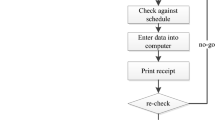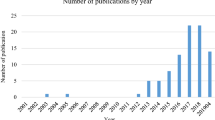Abstract
As the status of order picking in the warehousing and distribution system has been raised, the work-rest scheduling of picking becomes particularly important. Although science and technology have developed rapidly, manual picking is still essential and indispensable. However, previous researches focused on the study of the sequencing, ignoring human factors. The paper presents a work-rest schedule model in parts to picker picking system. Two objectives are proposed that include minimizing the picking time and minimizing picking error rate. And workers’ fatigue, workload is taken into account in the manual order picking systems because the fatigue can have a large influence on the picking time and the picking error rate. A genetic algorithm is used to solve a multi-objective optimization problem that the model concerns and looking for a Pareto front as the most effective methods for solving this problem. Once the original data is given, the work-rest scheduling model is built and the work sequence, and the number of breaks are determined to be chosen by decision makers. In addition, a case study of the model is used to confirm that the model is effective and it is necessary to consider the human factor in the picking system.
Similar content being viewed by others
References
Afzalirad M, Shafipour M (2018). Design of an efficient genetic algorithm for resource-constrained unrelated parallel machine scheduling problem with machine eligibility restrictions. Journal of Intelligent Manufacturing 29(2): 423–437.
Bachman A, Janiak A (2000). Minimizing maximum lateness under linear deterioration. European Journal of Operational Research 126(3): 557–566.
Bachman A, Janiak A, Kovalyov M Y (2002). Minimizing the total weighted completion time of deteriorating jobs. Information Process Letter 81(2): 81–84.
Battini D, Calzavara M, Persona A, Sgarbossa F (2015). Order picking system design: The storage assignment and travel distance estimation (SA&TDE) joint method. International Journal of Production Research 53(4): 1077–1093.
Cagliano A C, De Marco A, Mangano G, Zenezini G (2017). Levers of logistics service providers’ efficiency in urban distribution. Operations Management Research 10(3-4): 1–14.
Cai J Y, Cai P, Zhu Y (1998). On a scheduling problem of time deteriorating jobs. Journal of Complexity 14(2): 190–209.
Chen Y, Yao J, Zhong Y, Zhou J (2002). Ant system based algorithm for scheduling problem. Journal of System Engineer 17(5): 476–480.
Cheng T M, Chen Y L (2007). A GA mechanism for optimizing the design of attribute double sampling plan. Automation in Construction 16(3): 345–353.
Cho J K, Ozment J, Sink H (2008). Logistics capability, logistics outsourcing and firm performance in an e-commerce market. International Journal of Physical Distribution & Logistics Management 38(5): 336–359.
Choi C Y (2006). A generic fatigue model for frequently performed, highly repetitive combined material handling. Hong Kong: University of Hong Kong.
De Koster R, Le-Duc T, Roodbergen K J (2007). Design and control of warehouse order picking: A literature review. European Journal of Operational Research 182(2): 481–501.
Drury J (1988). Towards more efficient order picking, in IMM monograph No.1, The Institute of Materials Management, Cranfield, U.K.
Gademann N, Vande V S (2005). Order batching to minimize total travel time in a parallel-aisle warehouse. IIE Transactions 37(1): 63–75.
Gen M, Cheng R (2000). Genetic algorithms and engineering optimization, Vol. 7. John Wiley & Sons.
Goetschalckx M, Ashayeri J (1989). Classification and design of order picking. Logistics Information Management 2(2): 99–106.
Grosse E H, Glock C H, Neumann W P (2017). Human factors in order picking: A content analysis of the literature. International Journal of Production Research 55(5): 1260–1276.
Grosse E H, Glock C H, Jaber M Y, Neumann W P (2015). Incorporating human factors in order picking planning models: Framework and research opportunities. International Journal of Production Research 53(3): 695–717.
Gupta J N D, Gupta S K (1988). Single facility scheduling with nonlinear processing times. Computers & Industrial Engineering 14(4): 387–393.
Hancock P A, Desmond P A (2001). Stress, Workload, and Fatigue. Lawrence Erlbaum Associates Publishers.
Hanson R, Medbo L, Jukic P, Assaf M (2016). Manual picking from large containers-time efficiency and physical workload. IFAC-PapersOnLine 49(12): 1703–1708.
Henn S, Koch S, Wäscher G (2012). Order batching in order picking warehouses: A survey of solution approaches 105–137. Springer London.
Hsie M, Hsiao W T, Cheng T M, Chen H C (2009). A model used in creating a work-rest schedule for laborers. Automation in Construction 18(6): 762–769.
Ishibuchi H, Setoguchi Y, Masuda H, Nojima Y (2017). Performance of decomposition-based many-objective algorithms strongly depends on pareto front shapes. IEEE Transactions on Evolutionary Computation 21(2): 169–190.
Kim I Y, Weck O L D (2005). Adaptive weighted-sum method for bi-objective optimization: Pareto front generation. Structural & Multidisciplinary Optimization 29(2): 149–158.
Lavender S A, Marras W S, Ferguson S A, Splittstoesser R E, Yang G (2012). Developing physical exposure-based back injury risk models applicable to manual handling jobs in distribution centers. Journal of Occupational and Environmental Hygiene 9(7): 450–459.
Li Y L (2008). The study on the performance shaping factor of the human quality accident in the assembly process of the automobile accessory. Jilin university, Changchun, Jilin.
Lim J, Kwok K (2016). The effects of varying break length on attention and time on task. Human Factors: The Journal of the Human Factors and Ergonomics Society 58(3): 472–481.
Lins I D, Droguett E L (2011). Redundancy allocation problems considering systems with imperfect repairs using multi-objective genetic algorithms and discrete event simulation. Simulation Modelling Practice & Theory 19(1): 362–381.
Marichelvam M K, Prabaharan T, Yang X S (2014). A discrete firefly algorithm for the multi-objective hybrid flowshop scheduling problems. IEEE Transactions on Evolutionary Computation 18(2): 301–305.
Masmoudi M, Benaissa M, Chabchoub H (2013). Mathematical modeling for a rich vehicle routing problem in E-commerce logistics distribution. Advanced Logistics and Transport (ICALT), 2013 International Conference on IEEE, 290–295.
Napolitano M (2012). Warehouse/DC Operations survey: Mixed signals. Modern Materials Handling 51(11): 48–56.
Nastasi G, Colla V, Cateni S, Campigli S (2016). Implementation and comparison of algorithms for multi-objective optimization based on genetic algorithms applied to the management of an automated warehouse. Journal of Intelligent Manufacturing: 1–13.
Nechaev (2001). Work and rest planning as a way of crew member error management. Acta Astronautica 49(3): 271–278.
Ozturkoglu Y Y, Bulfin R L (2011). A unique integer mathematical model for scheduling deteriorating jobs with rate-modifying activities on a single machine. International Journal of Advanced Manufacturing Technology 57(5–8): 753–762.
Ozturkoglu Y Y, Bulfin R L (2012). Scheduling jobs to consider physiological factors. Human Factors and Ergonomics in Manufacturing & Service Industries 22(2): 113–120.
Pei J, Liu X, Fan W, Pardalos P M, Migdalas A, Goldengorin B (2016). Minimizing the makespan for a serial-batching scheduling problem with arbitrary machine breakdown and dynamic job arrival. The International Journal of Advanced Manufacturing Technology 86(9-12): 3315–3331.
Piasecki D (2013). Order picking: Methods and equipment for piece pick, case pick, and pallet pick operations, http://www.inventoryops.com/orderpicking.htm.
Richards G (2014). Warehouse Management: A Complete Guide to Improving Efficiency and Minimizing Costs in the Modern Warehouse. London: Kogan Page.
Rudin-Brown C M, Harris S, Rosberg A (2018). How shift scheduling practices contribute to fatigue amongst freight rail operating employees: Findings from canadian accident investigations. Accident Analysis & Prevention, S0001457518300332.
Sana S S, Ospina-Mateus H, Arrieta F G, Chedid J A (2018). Application of genetic algorithm to job scheduling under ergonomic constraints in manufacturing industry. Journal of Ambient Intelligence and Humanized Computing: 1–28.
Sheikhalishahi M, Azadeh A, Pintelon L, Chemweno P, Ghaderi S F (2016). Maintenance scheduling optimization in a multiple production line considering human error. Human Factors and Ergonomics in Manufacturing & Service Industries 26(6): 655–666.
Shi Y, Wang X, Qi L (2011). Human-factors engineering. Beijing: Tsinghua University Press, Beijing Jiaotong University Press, 103–104.
Smith T T G, Gallagher S (2018). Impact of loading and work rest intervals on muscle micro-trauma. International Journal of Industrial Ergonomics 66: 161–168.
Tharmmaphornphilas W, Green B, Carnahan B J, Norman B A (2003). Applying mathematical modeling to create job rotation schedules for minimizing occupational noise exposure. Aiha Journal 64(3): 401–405.
Tompkins J A, White J A, Bozer Y A, Frazelle E, Tanchoco J M A (2003). Facilities Planning. (3ed). New York: John Wiley.
Wang X Z, Wang G Q (2008). A heuristics algorithm for the replenishment operation problem in distribution center. Systems Engineering-Theory & Practice 4(4): 50–56.
Wäscher G (2004). Order Picking: A Survey of Planning Problems and Methods, pp. 323–347. Springer Berlin Heidelberg.
Watts B J (2010). The Effect of Varying Work Order Sequences on Physiological Responses in Combined Manual Material Handling, Auburn University.
Weber C L, Hendrickson C T, Matthews H S, Nagengast A, Nealer R, Jaramillo P (2009). Life cycle comparison of traditional retail and e-commerce logistics for electronic products: A case study of buy.com. 2009 IEEE International Symposium on Sustainable Systems and Technology (pp. 1–6). IEEE.
Wu H C, Wang M J J (2001). Determining the maximum acceptable work duration for high-intensity work. European Journal of Applied Physiology 85(3-4): 339–344.
Zhao X, Wu J, He Z(2015). Research on the work-rest scheduling of the manual picking with workers’ fatigue and workload. Journal of Systems Engineering 30(5): 703–710.
Acknowledgments
The authors thank the anonymous referees for their comments and suggestions.
Author information
Authors and Affiliations
Corresponding author
Additional information
Xiaosong Zhao is an associate professor in Department of Industrial Engineering in College of Management and Economics, Tianjin University. Dr. Zhao received her PhD in mechanical engineering from Tianjin University, China in 2000. Her research interests focus on human factor and quality management.
Na Liu is a master student in Department of Industrial Engineering in College of Management and Economics at Tianjin University in China. Her research interest focuses on human factor.
Shumeng Zhao is a master student in Department of Industrial Engineering in College of Management and Economics at Tianjin University in China. Her research interest focuses on quality management.
Jinhui Wu is a graduate student in Department of Industrial Engineering in College of Management and Economics at Tianjin University in China. Her research interest focuses on human factor.
Kun Zhang is a graduate student in Department of Industrial Engineering in College of Management and Economics at Tianjin University in China.His research interest focuses on human factor.
Rui Zhang is a graduate student in Department of Industrial Engineering in College of Management and Economics at Tianjin University in China. Her research interest focuses on quality management.
Rights and permissions
About this article
Cite this article
Zhao, X., Liu, N., Zhao, S. et al. Research on the Work-rest Scheduling in the Manual Order Picking Systems to Consider Human Factors. J. Syst. Sci. Syst. Eng. 28, 344–355 (2019). https://doi.org/10.1007/s11518-019-5407-y
Published:
Issue Date:
DOI: https://doi.org/10.1007/s11518-019-5407-y




